 April/May 2023 - Vol. 36, No. 6.
April/May 2023 - Vol. 36, No. 6.
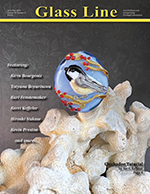
|
In This Issue

Kerri Fuhr Keffeler creates her nature-inspired lampwork beads in her West Coast glass studio in Bellingham, Washington. For more than 20 years, she has been creating beads inspired by the flora and fauna of the West Coast and has been teaching her techniques through tutorials and studio classes for many years. Birds, wildlife, and even mystical creatures such as dragons and unicorns are some of her favorite subjects to depict in glass. She also designs unique, one-of-a-kind jewelry pieces featuring her beads along with gems, pearls, and mixed metals. There is always a lot of creative chaos going on in her studio...

I began my relationship with glass in 2013. After about a year on the torch, life got in the way and my journey was paused until 2020 when I began working for a headshop/glass distributor in Northern California. This job, paired with a new-found sobriety, helped me rekindle the passion and desire I’d felt for the medium back in the beginning. Since January 2020, I’ve been full-time on the torch. The meditation that is staring into that flame and finding the patience to allow creativity to flourish is everything to me. I’ve tried my hand at plenty of other art forms, but glass is the only medium I can return to every day with vigor and desire to explore. Each day is a new opportunity to learn, to grow, and to test my technical skills and creativity. For me, glass is a medium that can only be limited by one’s imagination. Now back in Western Massachusetts, I work for myself and have begun to find my voice within glass.
This project uses 38 mm heavy wall tubing and Northstar Amber Purple frit...

For a few years, I rented a studio with friends, but the year 2020 changed all that, of course. QR-codes in Moscow allowed us to go outside only twice a week, which meant that I could not work in my rented workshop anymore. I decided to move to my home studio. The pandemic changed our lives a lot, but it also forced us to value each healthy day. With everything that happened, we became acutely aware of the fragility of life. It made me want to fill my life with beauty and love even more than before.
I live in a very small apartment and my studio is tiny but comfortable, and lets me work on the torch at any time. No need to stop at night. That is what I really like — I’m not an early bird.
All I needed to start working was 1 meter (3.28 ft.) of space to install my desk. I can be really compact...

Today, I am back in sunny Florida, working out of Zen Glass Studios as a private renter and providing experiences for the general public as an independent contractor. My glass creations are in the Zen Glass Gallery, as well as a couple of smoke shops around the area. I do Professional Art Crawls, along with seasonal markets, and I help fellow glass artists with creating their wholesale products. I do my best to keep my hands in both flame and furnace glass because I am always learning so much that can be applied to both practices of glass...

There is nothing new in the dot-patterned glass beads that I make. Thousands of years ago, bead craftspeople have been doing the basic of the basics — the simple work of “dotting.” The dotted beads are very tight beads for me. They consume the soul. Someone once said, “Dotting the dots is like copying a sutra.” That’s exactly right. I think it has something in common with Zen training. If you make one mistake, you have to start over. You can’t talk to anyone while making these beads.
I don’t think about it when I’m making art. I am happy and grateful if people who see my work are moved even for a moment, even just a little. I want to put my heart into each piece and create a piece of art.
I’m happy when I can make something good, and I want to create the next one.
Lampwork is an endless and eternal practice. I started after I casually entered a glass bead shop in a tourist area. It was crowded with customers, and I was looking at the beads displayed near the entrance. I didn’t go inside the shop. I was fascinated by the mystery of a single ball; I didn’t know who made it. A blue round glass containing three flowers that didn’t look like flowers. How did you make it? How could I do that?
I took one home and stared at it. I checked out a glass beads site on the internet. After three months, I took the plunge, bought the equipment, and started making some beads myself...

Creating small sculptures with high detail has always been the draw to make more and push my abilities. As a child, I would often use Sculpey, a heat-hardened plasticine clay, to craft my own toys and pieces for imagined table-top games. I‘ve carried this love for detail in miniature to making functional toys for adults. I chose the name KB.Toiz as a nod to my childhood while referencing the direction of my work in glass.
This detail-oriented miniature work is best represented by my micro sushi. I currently have eight styles of sushi on my “menu” and offer custom sushi and sashimi. Here are directions for how to make the first type of sushi I created: sushi roll with roe...
|
 February/March 2023 - Vol. 36, No. 5.
February/March 2023 - Vol. 36, No. 5.
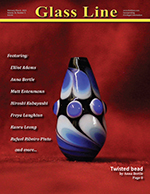
|
In This Issue
A Galaxy Marble by Kaoru Leung
The galaxy marble is a popular technique in Hong Kong (image 1) and is the first technique I learned in lampworking. This one used animal hair for bubble effects to make it a memorial piece.
This demo has four parts: part one, opal inclusion; part two, glass with animal hair bubble; part three, silver fuming; and part four, final assembly and background color (image 3)...

Today, creating and manufacturing glass beads is one of the main parts of my work. With every new design, I love it the more. I especially like delicate, unobtrusive colors and designs that are adapted to the wearer. Because I like challenges, I am happy about every opportunity to make a customer-fit piece of jewelry where I can incorporate the purchaser’s wishes. I attach great importance to individuality, which is why I prefer not to use prefabricated graphite shapers for making glass beads, but rather give the beads their individual shape on a flat paddle.
It is not uncommon for certain character traits or passions of people to inspire me to make new glass beads or color combinations.
What I particularly like about soft glass is that it enables smooth color transitions that almost look like they were painted, but I also work with borosilicate glass.
To me, no other material is as fascinating or offers as many processing options as glass does...

Tendril Traps is the name I have coined for the piece I made in this demo and my favorite technique. The name comes from the wispy tendrils of air that are trapped in the glass. Tendril Traps are an evolution of my time on the torch. Early on, I loved anemone implosions with air traps. Then I started twisting them to make my puck-shaped pendants. One time, I was making a huge puck and as I twisted it, I was struck by the beauty as it stretched from the side. Instead of finishing it in the puck style, I kept stretching it and thus the Tendril Trap was born...
Reticello Dichroic Pendant by Hiroshi Kobayashi
Glass itself is a beautiful material. I try to create works that make the most of its beauty. I want to give shape to the charm of glass that I am aware of as a creator.
There are still many things I don’t know about glass. I would like to continue pursuing glass with insatiable inquiry...

My wife blew glass for a few years and when she was pregnant with our second child, she stopped to pursue a nursing career and had great success with it. I ended up starting a shop with my friend Brent from Talent Glassworks — the guy I originally started with. We worked together for a decade, bouncing ideas off each other and experimenting. No matter how tight money was, and it was tight, I always took one day a week to experiment with new ideas, so I would not get stuck in the production trap; it was the right thing to do.
Eventually, I moved my shop home to avoid the commute and save on expenses. I spent a lot of years solo in the glass shop. It was a reflective time for me. Glass and I got to know each other very well. For many years, I had a distributor that took my work to all the glass shows. This really helped me with promoting my work because I was a bit of a recluse and seldom left my shop. Eventually, we parted ways, but it was a good learning experience and forced me to deal directly with my customers. This turned out to be a great evolution and allowed direct communication with my customers, so everyone felt happy and heard...

Once I overcame that stage through the knowledge that comes from a lot of research, a lot of study, a lot of practice, a lot of cut and burnt fingers, I started to reap the results, with pieces that are more and more elaborate and beautiful, with more techniques. Consequently, I gained a market and customers naturally.
I consider myself still new as an artist of glass, but more and more secure and sure of the professional choice that I made. Nowadays, my production focuses on glass cigarette holders—the most popular glass product in Brazil; companies look for them in quantity. I also produce pendants, pipes, one-hitters, nectar collectors, and other pieces aimed at the cannabis market.
This article presents a tutorial for producing a three-dimensional marble vortex pendant
...

I love sculpting and honing implosion techniques, which I currently do in soft glass. I have tried boro, which I loved for this, so when I have more time and space, I’d like to use boro to improve those techniques.
Because my technical skills aren’t at the level I’d like them to be yet, I wanted to try to bring something else to my work to make it more personal. And because I rarely buy new rods of glass, everything I make is a one-off experiment. This is how I came to make my little-world pendants.
I wanted to bring my illustration background into what I do with glass. A lot of people who see my little-world pendants at shows assume they have been painted on the glass with paint. I don’t know if I should be flattered or offended by the assumption. In a way, they are painted, but with rods of glass and fire.
Every hour melting is a combination of frustration and joy — learning which glass reacts happily and which colors are tricky, and then learning all over again when I pick up another unnamed rod from my pile of ends.
Sometimes I can find the perfect glass for a particular effect, and it even has a legible label, only to discover it went out of production years ago. But that’s what keeps all my little worlds unique, and that’s what keeps me learning and pushes me to try new ideas...
|
 December/January 2022/23 - Vol. 36, No. 4.
December/January 2022/23 - Vol. 36, No. 4.
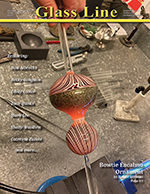
|
In This Issue
A Two-Layer Dotstack Marble by Zachary Hanks
On January 1, 2021, I made my first dotstack as part of a custom request. I didn’t think they were for me, but after some practice to finish the custom order, I simply couldn’t stop making them. Since then, I have made dotstacks almost exclusively — specifically marbles — and don’t plan on stopping anytime soon.
I’m just a nerd who likes a good craft beer, some “DnD,” and making marbles. One of my life goals is to inspire as many people as I possibly can to follow their dreams. Life is too short to not be doing the things you enjoy. In the words of Jim Carey, “If you can fail at doing something that you don’t even like, then why not risk failing at something that you enjoy?”
It is an honor to provide this article since the first tutorials I tried were from my buddies’ old Glass Line magazines
...

I started my glass journey in 2006, after having been exposed to it back in 1993. I was into music and snowboarding while my roommates blew glass in the garage. When one of my roommates had a business manufacturing glass, he gave me the opportunity to apprentice there and help grow his business. He had me read the book Contemporary Lampworking and the first page had me hooked, because it featured the silhouette of the Bones Brigade standing on a halfpipe. I also picked up a good work ethic by watching Milon Townsend videos. I believe that balancing art and craftsmanship is important in being able to support this wonderful habit ...

A few years ago, I started making higher-end ornaments as an experiment, and found a good amount of demand for them. I love creating line-work patterns because they never seem to get old. One of my favorites is the bow-tie technique, and this ornament design showcases it nicely. This technique can be applied to whatever you want to make. As with all glass objects, the possibilities are endless, and there are many ways to achieve great results. This tutorial is what has worked well for me, and currently how I like to make this kind of ornament.
One helpful tip about learning any new technique: Always the finish the whole piece, even if you mess it up. That way, you can have multiple learning experiences with one piece. Every once in awhile, though, it does feel good to throw the thing in the bucket and just start over ...

I remember watching my great aunt do tatting (a lace-making technique), and it always fascinated me. Combining glass to make lace equals ... Yes, please! Some of the best qualities of glass for me are the transparency and beautiful lace-like effects from glass canes. Isn’t it interesting that Burano, an island in Italy known for lace-making artists, is right near Murano (an island known for Venetian glassmaking)? Maybe there’s some overlap. After working at the torch and watching glassblower videos about various cane-making techniques, I am now implementing some of those techniques at my torch using soft glass.
Three techniques I use to make glass with a lace-like appearance are encasing, cane-making (zanfirico), and hollow beads ...

I don’t use molds for modeling glass. I work in the air, using heat, gravity and rotation, and a few unconventional or unusual tools.
I think creativity is seriousness, a spontaneous gesture, a moment, a mood. I’m not in search of the perfect glass bead, but of an object that is in harmony with the environment surrounding it, coherent and close to my creative impulse.
I gain inspiration from the shape of objects and their shadows, geometries, architectures, and surrealist art. I also aim to enhance surfaces with relief decorations by combining several processing techniques, such as grinding, sandblasting, printing, and engraving. I consider a glass bead as a little sculpture to wear.
I also enjoy playing with brightness and opacity as “special effects” to add to my glass shapes ...

I have been fascinated by both art and fire for as long as I can remember. I started drawing as soon as I could hold a pencil and soon enough, I was also dabbling in painting, pastels, fiber art, wire-wrapping, papermaking, ceramics, and anything else I could get my hands on. At the same time, my interest in fire was also blooming and I became a well-practiced fire-dancer. It seemed only natural that one day my two favorite interests would meet.
A chance encounter with a friend of a friend resulted in her offering to give me a lampworking lesson, and from my first gather, I was instantly hooked. It’s been 10 years since that first lesson, and I have been working with glass ever since. In recent years, I have narrowed my focus to specialize in combining my glasswork with hemp, coconut buttons, and sterling silver to make ethical jewelry with fair-trade and eco-friendly materials ...

I find inspiration in nature, going to the beach, diving, fishing, sitting on the deck watching birds and other wildlife, and looking at the stars. My vision is that my beads will bring those kinds of happy memories and quiet moments of wonder into the everyday lives of bead lovers. I’ve been honored to win several awards from the East Valley Artists’ Annual Show and to be juried into the Olive Hyde Art Show for the last five years. I have given virtual demonstrations for local art groups and taught virtually for the previous three years at the Glass Symposium.
Tide pools inspired this ocean scene. I love exploring the tiny environments full of sea life — anemones, little crabs, clams and mussels, and sometimes a sea star. The Tide Pool bead is one that I like making in all different colors: silver glass, dichroic, blue, teal, aqua, pink, purple, and even red and orange. But you don’t need those colors; use your own favorites
...
|
 October/November, 2022 - Vol. 36, No. 3.
October/November, 2022 - Vol. 36, No. 3.
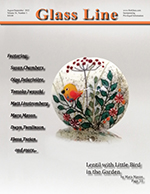
|
In This Issue
Making a Hedgehog by Tomoko Iwasaki
I melt glass and put all my heart and soul into forming it. I love fusing, which is a slow process, and burner work, which is a moment of nothingness toward the flame.
Before starting this project, remember that the blowpipe is also made of glass, but it has a different expansion coefficient, so always keep the end of the pipe warm to prevent it from breaking.
After working on the area you want to make, immediately warm up the base of the pole and the whole area...

I have fashioned artwork with glass in my spare time since 2014 (yes, I’m a hobbyist), but it has become more intensive for the past few years as my skills have improved with practice and technic knowledge, also thanks to a course with Astrid Riedel in 2019. Needless to say, there’s still plenty of room for learning!
I work in a limited space in the laundry room in my flat in Udine (Italy) … maybe that’s why my beads are miniature oriented. I make small beads in soft glass, with delicate little motifs inspired by meadows and gardens. I quite like working with extremely thin stringers, especially those like “hairs,” combining bright, lively colors. It’s an actual exercise of patience that I find relaxing and, drawing after drawing, it draws me into a dimension like children’s fairy tales.
This tutorial shows how to realize a “naturally messy” garden with flowers and a little bird on a lentil bead. I prefer to decorate both sides of the lentil — you have to repeat the same process on the front and on the back of the bead each time...

I am a glass artist based in Belgium. I have been making jewelry for more than 15 years now, and I always dreamed of making my own beads. In 2017, while browsing on the internet, I saw floral lampwork beads made by Dolly Ahles Palmer. I was so fascinated and could hardly believe that it was possible to make such beads at home. I was looking up information day and night, and then decided to follow a basic class in Antwerp.
That is when I fell in love ... My first beads were far from the ones I saw on the internet, but they were the most beautiful ones in the world for me. Despite a difficult financial situation at that time, I was able to buy my first equipment. I was practicing in our garage at the beginning. After a year, I had a separate lampwork studio thanks to my husband, who supports me in everything.
I have been lampworking ever since and find pleasure in every torch minute. If you dream about something, I would say — go for it...

I now have my own studio and have been working there for the last four years or so, mostly as a hobbyist when I have time off work. Eventually I’d like to move to flameworking full-time again, but I do have lots of time to practice and develop new skills and techniques. Lately I’ve been practicing learning line-work techniques and have also picked up cold-working using a faceting machine.
My best advice for anyone at any stage of this incredible journey is to never stop learning, always be looking for inspiration, and find ways to give back. Education is the most important thing to keep this craft moving forward...

The best thing about making a dragon is that no one can tell you the nose is too long, the ears are in the wrong place, or the color isn’t right. You can get fancy or go plain as your heart desires. A dragon is what you imagine, and no one can say otherwise.
(Sculptural pieces are appealing, but can be intimidating — especially in soft glass. If you would like to try something three-dimensional but ease your way into it, try a bead with a semi-sculptural raised image.)
The fire-breathing tradition of a dragon fits nicely with the heat control that you will need to make sculptural pieces...

I am an artist and a designer with a bachelor’s degree in fine arts. In the past, I created two fashion design collections with the technique of painting fabrics (batik) for beauty contests and various entertainment shows, as well as several collections of costume jewelry and accessories. I now specialize in lampwork only.
Cactuses are very diverse in shape and colors in nature. Creating them in glass is a rich field of activity for an artistic person. Images of miniature cactuses can provide inspiration.
...

For the first two years, I did not buy glass, but melted bottle glass and float glass, getting a feel for how quickly it went from molten to dripping off the mandrel and how big I could make a piece of glass and not have it fail until it could be annealed. Having a limited budget meant that all my first tools came from the kitchen or thrift store: a stainless steel butter knife for shaping, a stainless steel spoon with grooves in the edges to make olive-shaped beads, a stainless steel egg slicer and a cheese grater for interesting surface texture. I still have all these tools; they are remarkably similar to those being mass-produced and sold as glass-forming tools today...
|
 August/September, 2022 - Vol. 36, No. 2.
August/September, 2022 - Vol. 36, No. 2.
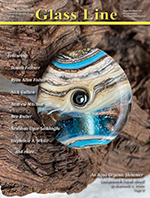
|
In This Issue
Wigwag Cane and Beads by Neslihan Ugur Sadıkoğlu
I have always had an interest in fine arts, but I couldn’t be in the pole. I have worked in various industries — automotive, textile, jewelry, banking. The monotony of banking did not excite me and that’s why I quit. Life brought me back to glass again in 2018. Maybe the glass wanted it.
Glass definitely has an effect that attracts people. It engages all the emotions through its clarity, simplicity, brightness, dullness, fragility, and durability. I fell in love with the beauty of these feelings in 2018 and have received training from various private and public institutions.
This is how I make wigwag cane and beads ...

Learning to make larger focal beads involved a steeper learning curve than I expected. As an artist, I am highly critical of my work. It took a lot of time and practice to get to the point where I am happy with most of my beads! One of my greatest challenges is accepting the “creative flaws” as art. Many of my perceived flaws are not obvious to someone else. There are countless beads in the bottom of my fish tank that I felt were flawed; poor fish!
Another challenge with larger focal beads is maintaining the balance of the bead as you build up the glass. Learning how to layer the glass helped me smooth out this process. I also found that using a larger bead roller was helpful in figuring out where I needed to add more glass. Over the years, these occasional “ah-ha” moments can take you to another level. It can take some time to learn how the glass behaves and how it reacts with other glass. Sometimes, you can get some amazing reactions when two colors are side-by-side.
This tutorial could be a springboard to creating your own unique pieces. Learning from others is the only way to improve your own talent. That can be difficult for artists who do not like to “copy” other artists’ work. However, it can be a necessary step to help you get to your own next level
...

I’ve always liked both outside and inside worked tubing glass designs and done a lot of both over the years, but in recent years, I have been interested in blowing solid forms into hollow forms with a blowtube. I enjoy blowing out solid color or remixed marbles with colors that luster and strike or sparkle, and have come to the conclusion that almost any remix or solid marble technique can be a hollow form. This milli pendant uses 15 stacked up dots of color to fuse into a marble and blow out with the goal of creating circles of color around a Lion of Judah image by one of the milli-making masters, Jesse Taj
...

My latest passion is mini-vessels. The great thing about these vessels is you don’t need a blowpipe, or the skill of making a hollow bead. It’s a good thing I like making them, because they sell well online. Each mini-vessel will hold three to five drops of essential oil or perfume. They also can be used to hold other treasures, such as a small love note, cremation remains, or a treasured pet’s fur
...

I have been working with glass for the past 20 years as a pipemaker and pendant artist. My journey has taken me all around the country, learning different styles and techniques, and providing the opportunity to meet other artists. I was homeless for 11 years, but still managed to pursue my passion for glassblowing in various shops. Here and there, I would sell my art to stores or civilians on the street while I busked for my dinner and material. Just before Covid, I started my own studio, investing everything I had to follow my passion. Covid really affected my business — it’s been hard to get noticed or make sales; stores around me stopped buying and invested heavily in imports, so I have been trying to promote my business online. I have been laughed at by shops or told to get a “real job,” but even with this struggle comes reward; I’m still pursuing my love for glassblowing and doing everything in my reach to follow my dreams and aspirations of creating quality affordable glass art
...

One of the things I enjoy most about glass is the design aspect. I have always loved puzzles, and my multi-section pieces reminded me a lot of that childhood activity: finding the right pieces to put together and matching that process with the multitude of color options available today. One of the most important things I took from my apprenticeship with Brad was designing vacstacks with colorful patterns — these became my calling card.
Three years ago, I moved to Denver, one of the eimageenters of glass. I enjoy teaching and have always wanted to pass down this knowledge and give it new life. The space I work in now is open for artists to collaborate and share techniques in a relaxing atmosphere. My inspirations come from many things, including the beautiful colors of the Colorado landscape, along with fashion, pop culture, and everyday objects.
This piece is a full-spectrum linework Sherlock build with Sonic from Greasy Glass
...

I was a big collector before I started to work with this medium myself. When I lived out in California, I met a glass artist who let me come to the studio and watch them work.
Watching someone make glass ignited the flame in me, and I decided I wanted to make it instead of collect it. I saved up for a couple years to buy some equipment and took some classes locally to learn how to make basic pendants. From there, I went to a glass summer camp where I met a bunch of cool people who were more than willing to show me what I wanted to know.
My favorite things to make at the moment are turtles, flower marbles, and flower pendants. Here’s how I make a turtle
...
|
 June/July, 2022 - Vol. 36, No. 1.
June/July, 2022 - Vol. 36, No. 1.
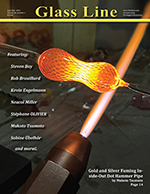
|
In This Issue
Rainbow Fumed Flower Implosion Marble by Rob Brouillard
I am an Air Force veteran, a full-time physical therapist at the VA in Boise, Idaho, and father of two great kids. I started my journey in glass on a date with my wife at one of the local hot shops. I made a blue cup and wondered, “Where was this my whole life?” After I spent two years at the hot shop, Filip Vogelpuhl at Boise Art Glass suggested that I learn the torch and I started my apprenticeship. His specialty is marbles and he challenged me to push my flower marbles further and further.
My fuming technique took a big step forward when I took an online class by Freddy Faerron, who went over the rainbow fume technique. I’ve been involved in making marbles for the FaceBook group World’s Biggest Marble Hunt for over a year now. I also started powerlifting three years ago and claim to be the world’s strongest glass artist, with a bench press of 335 lbs., squat of 455 lbs., and deadlift of 485 lbs...

After many years of creating products for the medical industry as a mechanical engineer, I now devote my time to the creation of jewelry. In my workshop located near Toulouse in France, I create unique pieces in an artisanal way. Inspired by contemporary glass artists, such as Lino Tagliapietra, Toots Zynsky, Nancy Callan, Nathan Sandberg, I try to realize on the scale of the jewel, the work they do on monumental pieces. The path is exciting and fascinating.
This research work started for me in 2013 out of love for color, transparency and material. This amazing material requires an adaptation to rules that are far to be intuitive. It is an infinite series of learning, trials, discoveries, surprises, that I use to create these glass beads. I combine in my work different techniques such as flame working, molding, murine creation, blowing and cold work. Associating the constraints and assets of the glassmaker and the jeweler, allows the realization of colored and luminous ornaments...

My favorite technique is the old-cool technique of fuming inside-out dots. The dots extending from the inside of the glass emerge three-dimensionally, and make a nice pattern. The process of regularly striking hundreds of dots inside the glass tube is similar to Zen. I am grateful for being able to use the completed pipe — it helps me establish the significance of my self-confidence.
Fuming uses gold and silver to enhance a clear color. Gold and silver are minerals, so their contribution can be called gems.
A glass pipe is an art and a tool. You can smoke with a glass pipe, get tar, change colors, make patterns appear, and make it easy to smoke. You will not be able to make the best glass pipe the first time. That’s why I think I’m an artist and a craftsman...

Italian glass (COE 104) is most often used in beadmaking — few artists use it for sculpture work. My husband and I developed our line, known as “Bling Squared Cute Glass,” over the past 14 years. It consists of adorable animal designs, sculpted in pendant and figure form. We create our figures using traditional marble-making techniques as a base. While the more traditional Italian style of soft glass sculpture features lovely, elongated forms, our preference, and the esthetic our work, is more rounded, with an emphasis on cute and expressive characters. Once we have a solid base, we add our trademark “cute” with dot stacks and sculptural details.
When designing these highly stylized pieces, we begin by considering the animal we want to recreate and thinking about the details that make the animal identifiable. For example, a bird has to have a beak and wings, a turtle needs a shell, a fish needs fins, and so on. Some animals are a little harder to pin down (how does one make a stylized hamster look different from a stylized rat?), so research and planning are key. We plan the two-dimensional details and the three-dimensional details somewhat separately. Drawing a circle and placing the design around it is helpful.
Verity Fox was one of our early designs and continues to be one of our most popular sellers. The most recognizable elements of a fox are the coloring, tail, muzzle, and ears, so that is where we focused the design. Here’s how we put her together...

Four years ago this April, I was able to take on a new role: a partnership of sorts with the gallery and studio Witch DR in Salem, Massachusetts. I have been blessed with this opportunity to work with a team of like-minded individuals who have now become my family. It’s has been an amazing experience to have the constant feedback and encouragement from such a strong team. Being part of this team has allowed me to venture even deeper into my current body of work and the ability to explore the possibilities of flame-working to a whole new level. I’m fortunate to be surrounded by so much support every day.
Over the past 24 years, I have had the opportunity to either attend, host, or be a part of so many workshops and classes from so many who inspire not only me but the entire movement. I will always be a student of the medium and there will always be something new to learn.
The piece described here is similar to one that has been accepted into New Glass Review 42, a yearly publication from the Corning Museum of Glass. It is a “chillum” that takes inspiration from nature in the form of a birch tree. (A chillum is a small, hollow tube with a bowl on one end and a mouthpiece on the other.)
...

Making lampwork beads was a hobby that now has occupied me for exactly 15 years, and it’s a great balance to my technical job in IT. I love to make colorful beads and figures. Currently, I’m focusing on making finger rings. My “studio” is just a table in my home office with a burner, a kiln, and proper ventilation. I’m using a Nortel Minor burner, operated with an oxygen concentrator/gas cylinder. I only work with soft glass. My favorite tool is a simple stainless steel spatula that I use to manipulate small areas of hot glass. I live with my husband and cats in the northern part of Germany, just a short trip from the Baltic Sea and Denmark, so apart from making beads, there’s a lot to do out in nature, like riding my kick-bike or stand-up paddling...

My activity in flameworking officially started in 2010, during a visit to the Museum of Glass in Tacoma. Besides being enthralled by the work on display by Dale Chihuly and other artists, I took a couple of introductory classes in flameworking and furnace work. I spent much of the rest of that trip visiting glass galleries and inquiring about how to learn about flameworking. One of the first pieces of advice I received was to subscribe to Glass Line.
My passion for flameworking actually started nearly 60 years ago, though, when I would stand for what seemed like hours watching the flameworker at our local tourist shop make dolphins, fish, and sailing ships. That passion stayed with me throughout my 40-year career as a marine biologist, studying the effects of pollution on coastal waters. I first learned of the work of Rudolf and Leopold Blaschka through scientific journals, which helped form my goal of capturing the beauty and realistic forms of sea life in glass. I also enjoy combining fusing and flameworking techniques to make items such as lamps, birdfeeders, and hats.
With my relatively late start in doing flameworking, I have emphasized learning from others through studio workshops and online courses. I have been fortunate to have had valuable experiences with Loren Stump, Suellen Fowler, Kevin O’Grady, and many others. Sometimes, you don’t realize what you have learned from these classes until long after they have ended.
The idea for this cute little pufferfish came from a workshop challenge to make a glass-themed hat. I chose to make a fused head of brain coral and decorate it with some of my favorite coral reef inhabitants. It’s a bit heavy, but I’m sure it would do a great job of keeping the rain out!
This tutorial is a good introduction to working with tubing, because the piece is relatively small and can accommodate some variations in shape and still look nice. Just be careful not to overheat the white tube, which is sensitive to boiling, and remember to reheat the entire body frequently during the later stages of construction...
|
 April/May, 2022 - Vol. 35, No. 6.
April/May, 2022 - Vol. 35, No. 6.
|

